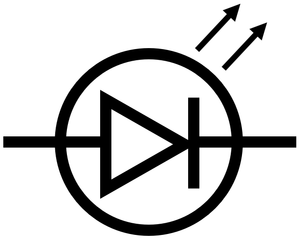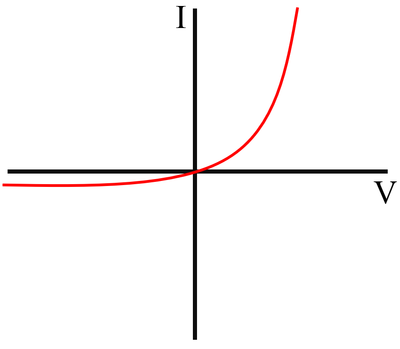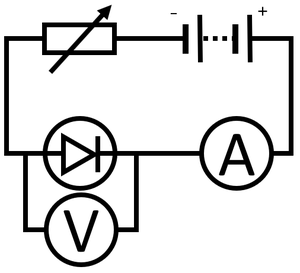Difference between revisions of "Light Emitting Diode"
| (3 intermediate revisions by 2 users not shown) | |||
| Line 20: | Line 20: | ||
====Explanation==== | ====Explanation==== | ||
: The [[Electrical Resistance|resistance]] of an '''LED''' is very low for [[Electrical Current|current]] in the forward direction and very high in the back direction. | : The [[Electrical Resistance|resistance]] of an '''LED''' is very low for [[Electrical Current|current]] in the forward direction and very high in the back direction. | ||
| + | |||
| + | ====Obtaining the IV Graph==== | ||
| + | {| class="wikitable" | ||
| + | |- | ||
| + | |[[File:DiodeIVGraphCircuit.png|center|300px]] | ||
| + | | style="height:20px; width:300px; text-align:left;" | | ||
| + | #Connect an [[ammeter]] in [[Series Circuit|series]] with the '''LED''' to measure [[Electrical Current|current]] through the '''LED'''. | ||
| + | #Connect a [[voltmeter]] in [[Parallel Circuit|parallel]] with the '''LED''' to measure the [[Potential Difference|potential difference]] across it. | ||
| + | #Use a [[Variable Resistor|variable resistor]] in [[Series Circuit|series]] with the '''LED''' to vary the [[Potential Difference|potential difference]] across the '''LED'''. | ||
| + | #Start with a [[Potential Difference|potential difference]] of zero and increase the [[Potential Difference|potential difference]] by an interval of 0.2V up to 2V. | ||
| + | #Recording the reading on the [[voltmeter]] and [[ammeter]]. | ||
| + | #Reverse the connections on the [[battery]] and repeat steps 4 and 5 to find the I-V relationship for negative [[Potential Difference|potential difference]] and [[Electrical Current|current]]. | ||
| + | |} | ||
| + | |||
| + | ===References=== | ||
| + | ====AQA==== | ||
| + | |||
| + | :[https://www.amazon.co.uk/gp/product/0008158770/ref=as_li_tl?ie=UTF8&camp=1634&creative=6738&creativeASIN=0008158770&linkCode=as2&tag=nrjc-21&linkId=ec31595e720e1529e49876c3866fff6e ''LED (light emitting diode), page 52, GCSE Physics; Student Book, Collins, AQA ''] | ||
| + | :[https://www.amazon.co.uk/gp/product/1471851370/ref=as_li_tl?ie=UTF8&camp=1634&creative=6738&creativeASIN=1471851370&linkCode=as2&tag=nrjc-21&linkId=01c69b0ae058f809cf636033e6ba793e ''Light-emitting diodes (LEDs), page 43, GCSE Physics, Hodder, AQA ''] | ||
| + | :[https://www.amazon.co.uk/gp/product/1782946403/ref=as_li_tl?ie=UTF8&camp=1634&creative=6738&creativeASIN=1782946403&linkCode=as2&tag=nrjc-21&linkId=32a0abb60dff015b15b50e9b1d7b4644 ''Light-emitting diodes (LEDs), page 60, GCSE Combined Science Trilogy; Physics, CGP, AQA ''] | ||
| + | :[https://www.amazon.co.uk/gp/product/1782945970/ref=as_li_tl?ie=UTF8&camp=1634&creative=6738&creativeASIN=1782945970&linkCode=as2&tag=nrjc-21&linkId=a120d24dcc7cc7a58192069a3aafc1d2 ''Light-emitting diodes (LEDs), page 62, GCSE Physics; The Complete 9-1 Course for AQA, CGP, AQA ''] | ||
| + | :[https://www.amazon.co.uk/gp/product/1471851354/ref=as_li_tl?ie=UTF8&camp=1634&creative=6738&creativeASIN=1471851354&linkCode=as2&tag=nrjc-21&linkId=9012a0d354024419214fb3ad5ac44ba0 ''Light-emitting diodes (LEDs), pages 293, 298, GCSE Combined Science Trilogy 1, Hodder, AQA ''] | ||
| + | :[https://www.amazon.co.uk/gp/product/1471851370/ref=as_li_tl?ie=UTF8&camp=1634&creative=6738&creativeASIN=1471851370&linkCode=as2&tag=nrjc-21&linkId=01c69b0ae058f809cf636033e6ba793e ''Light-emitting diodes (LEDs); circuit symbol, page 38, GCSE Physics, Hodder, AQA ''] | ||
| + | :[https://www.amazon.co.uk/gp/product/019835939X/ref=as_li_tl?ie=UTF8&camp=1634&creative=6738&creativeASIN=019835939X&linkCode=as2&tag=nrjc-21&linkId=57e96876985fc39b1a3d8a3e3dc238b6 ''Light-emitting diodes, pages 52, 57, GCSE Physics; Third Edition, Oxford University Press, AQA ''] | ||
| + | |||
| + | ====OCR==== | ||
| + | :[https://www.amazon.co.uk/gp/product/0198359837/ref=as_li_tl?ie=UTF8&camp=1634&creative=6738&creativeASIN=0198359837&linkCode=as2&tag=nrjc-21&linkId=3c4229e8b023b2b60768e7ea2307cc6f ''Light-emitting diodes (LEDs), pages 106-107, Gateway GCSE Physics, Oxford, OCR ''] | ||
Latest revision as of 08:52, 14 December 2019
Contents
Key Stage 4
Meaning
A light emitting diode (LED) is an electrical component which emits light when electricity passes through in one direction and prevents electricity from going in the reverse direction.
About Light Emitting Diodes
- LEDs have a low resistance in one direction and emit light but a very high resistance in the reverse direction and do not emit light.
- LEDs can be used to change an alternating current into a direct current.
IV Graph
Description
The IV Graph for an LED shows that:
- For a positive potential difference the current increases rapidly with an increase in potential difference
- For a negative potential difference the current remains negligible and does not increase as the potential difference becomes larger.
Explanation
- The resistance of an LED is very low for current in the forward direction and very high in the back direction.
Obtaining the IV Graph
|
References
AQA
- LED (light emitting diode), page 52, GCSE Physics; Student Book, Collins, AQA
- Light-emitting diodes (LEDs), page 43, GCSE Physics, Hodder, AQA
- Light-emitting diodes (LEDs), page 60, GCSE Combined Science Trilogy; Physics, CGP, AQA
- Light-emitting diodes (LEDs), page 62, GCSE Physics; The Complete 9-1 Course for AQA, CGP, AQA
- Light-emitting diodes (LEDs), pages 293, 298, GCSE Combined Science Trilogy 1, Hodder, AQA
- Light-emitting diodes (LEDs); circuit symbol, page 38, GCSE Physics, Hodder, AQA
- Light-emitting diodes, pages 52, 57, GCSE Physics; Third Edition, Oxford University Press, AQA


